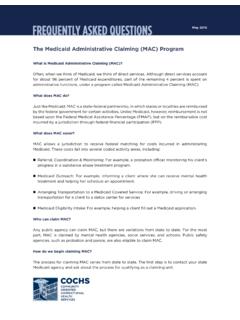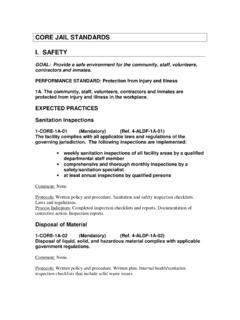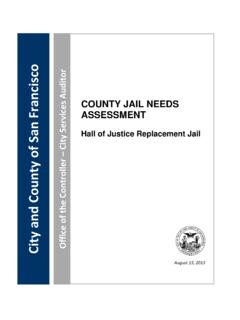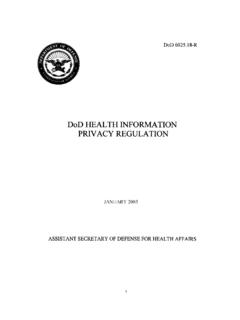Transcription of Meaningful Use and Corrections: Unknown Opportunities
1 June 2014 IntroductionAcross the country, jurisdictions are becoming increasingly cognizant of the enormous number of dollars they spend every year on health care provided in local and county jails, the opportu-nities to offset those expenditures under Medicaid expansion in some states, and the need for health information technology (health IT) in order to fully leverage those Opportunities . And, like other health care providers exploring health IT implementation, they are weighing whether to participate in the federal government s incentive programs to promote adoption of elec-tronic health record (EHR) systems, which are commonly referred to as Meaningful use.
2 Meaningful use is the linchpin of the Medicare and Medicaid EHR Incentive Programs, estab-lished under the Health Information Technology for Economic and Clinical Health (HITECH) Act to provide incentive payments to eligible providers that adopt and demonstrate mean-ingful use of certified EHR technology. Providers demonstrate Meaningful use by attesting to certain criteria for different stages of Meaningful use. Interest in Meaningful use among correctional health services (including both in-house health care providers and contract providers) is manifesting itself at different levels.
3 A few correctional health services have recently begun to participate in Meaningful use. Others are thinking about it, while still others are pursuing plans to acquire and implement EHR systems associated with Meaningful use, even though they do not intend to participate in the program. This article provides an overview of the Meaningful use landscape, emphasizing the applica-bility of Meaningful use to health care provided in jails, as well as exploring the benefits and difficulties of participating in this program for jail health care providers. It also describes the steps that jail health care systems must pursue in order to participate in Meaningful use.
4 The Meaningful use program consists of two separate programs: one for Medicare and one for Medicaid. As safety net providers, correctional facilities may participate only in the Medicaid program. Against this backdrop, the article addresses the reasons why jail health services should explore participating in Medicaid Meaningful use. Meaningful use offers jails an oppor-tunity not only to access funds for needed EHR systems but also, crucially, to connect with the mainstream health care system and significantly improve the health of a very high-risk and historically disenfranchised population, a goal that is strongly connected to reducing health disparities and to the triple aim of health Use and Corrections: Unknown OpportunitiesBy Ben Butler, Chief Information Officer, Community Oriented Correctional Health ServicesJune 2014 Meaningful Use and Corrections.
5 Unknown Opportunities 2 Although jails are critical safety net providers, historically they have not been recognized as such. An estimated million people pass through the nation s 3,300 jails annually. They are disproportionally male, persons of color, poor, with high rates of chronic and infectious disease, injuries, mental illness, and substance use disorders. Because they tend to cycle in and out of jail quite rapidly average length of stay is days they are in frequent contact with the local communities in which they reside and thus have significant impacts on community health.
6 1 Prior to 2014, the vast majority of the jail-involved population lacked health insurance of any kind, with one study finding that 90 percent of people released from jail were But as more individuals become insured under Medicaid expansion, a significant number of them will have justice involvement. This means that they very likely will receive some of their health care while in release, they will return to their local communities, where, if they are enrolled in Medicaid, they will very possibly for the first time be able to access health care from other than an emergency provider for their ongoing health problems.
7 In an ideal world, the health care they received in jail would be connected to the health care that they receive in the community, both to ensure continuity and avoid duplication of that ideal is not the reality. Currently, most health care provided in jail resides in a black box. This is a critical break in the continuum of care for a very high-risk and costly technology that enables the sharing of health data through interoperable EHR systems and health information exchange (HIE) can take jail health care out of the black box and connect it with community health care.
8 And interoperability, as required under Meaningful use, will be the key to making that happen. In an environment with IT interoperability, providers can share health data seamlessly and the continuum of care can be made whole and its effec-tiveness maximized. However, jails face a serious obstacle to participating in Meaningful use, which was not designed with jails in mind. The requirement for patient engagement under Meaningful use will be extremely challenging, if not impossible, for jails to meet. Although jails are required to provide needed health care to individuals in their custody, their primary purpose is to maintain custody and security of those individuals, who, as noted, tend to cycle in and out jail very rapidly, some-times within a matter of days.
9 In such an environment, it is very difficult to engage patients in their health already part of the mainstream health care system including policymakers and health plans generally have little understanding of the issues surrounding jail health care and the chal-lenges that jail health services face when trying to integrate into community systems of care. But as the Meaningful use program undergoes a period of adjustment and public comment, there is an opportunity both for jails to provide their input and make their challenges known and for policymakers to gain a better understanding of how they can make Meaningful use more accessible to jails, thus promoting health care connectivity.
10 June 2014 Meaningful Use and Corrections: Unknown Opportunities 3 Overview of Meaningful UseHITECH, enacted in 2009 as part of the American Recovery and Reinvestment Act, directed the Office of the National Coordinator for Health Information Technology (ONC) to promote the adoption and Meaningful use of certified EHR technology. In response, ONC established a certification program, developed EHR certification criteria, and selected certification bodies.









